COVID-19 has now infected more than 35 million Americans and claimed the lives of more than 600,000.REF After the introduction of the vaccines, COVID-19 cases and deaths declined significantly, although there has been a recent uptick in cases due to the Delta variant.
The Delta variant, scientifically known as the B.1.617.2. variant, is a mutation of the coronavirus that surfaced in India in December 2020. The strain rapidly became the dominant variant in several countries, including the United Kingdom.REF According to Centers for Disease Control and Prevention (CDC) estimates, at the end of July 2021, the Delta variant represented more than 80 percent of new U.S. COVID-19 cases.REF This fact has surely contributed to Americans’ concerns over the efficacy of vaccines, but the data show that vaccines provide significant protection against serious illness or death from the virus, including the Delta variant.
While some uncertainty remains, as it would with any novel virus, the CDC has done a poor job of using existing evidence to quell the public’s concerns about vaccine safety and efficacy. Indeed, CDC officials and other government officials have added to Americans’ confusion with conflicting messages, often unconnected to any supporting data.REF In the latest such message, on July 27, CDC Director Rochelle Walensky announced new guidelines that imply that the vaccines offer little protection against the Delta variant.
The new guidelines recommend (among other things) that all people, including the fully vaccinated, wear masks “in public indoor settings” in areas of high disease proliferation.REF After being criticized for failing to support its recommendations with data,REF the CDC released a new report on July 30 that, supposedly, contained the evidence.REF At almost the same moment that Walensky was insisting that the new data supported the recommendations for vaccinated people, a member of the White House COVID-19 response team was chastising The Washington Post and The New York Times for being “completely irresponsible” by reporting the supposed heightened risk of infection for the vaccinated.REF Faced with these kinds of conflicting messages, it is easy to see how the public could be confused about the Delta variant and the efficacy of vaccines.
As demonstrated in this Backgrounder, while news stories referred to the new CDC data as “sobering”REF and “unsettling,”REF such descriptions are, at best, severely misguided. In fact, even though The Washington Post referred to the new CDC report as a “pivotal CDC study,”REF the report is not a research study at all. It merely explains some of the data collected in response to a COVID-19 outbreak in Barnstable County, Massachusetts. There was no controlled study of any sort—not of the effectiveness of masks, or even of the basic transmission of COVID-19. The report merely describes data from a sample that is not representative of the U.S. population, Barnstable, or (possibly) even the festivities at which the outbreak occurred.
CDC leadership should have heeded the warning of the report’s own authors, who specified that “data from this report are insufficient to draw conclusions about the effectiveness of COVID-19 vaccines against SARS-CoV-2, including the Delta variant, during this outbreak.”REF Despite the misuse of the data in the CDC report, the overall evidence remains clear: Vaccines have provided significant protection against serious illness or death from COVID-19.
COVID-19 Cases, Deaths, and Vaccines
Chart 1 presents new daily cases and deaths over the course of the pandemic.
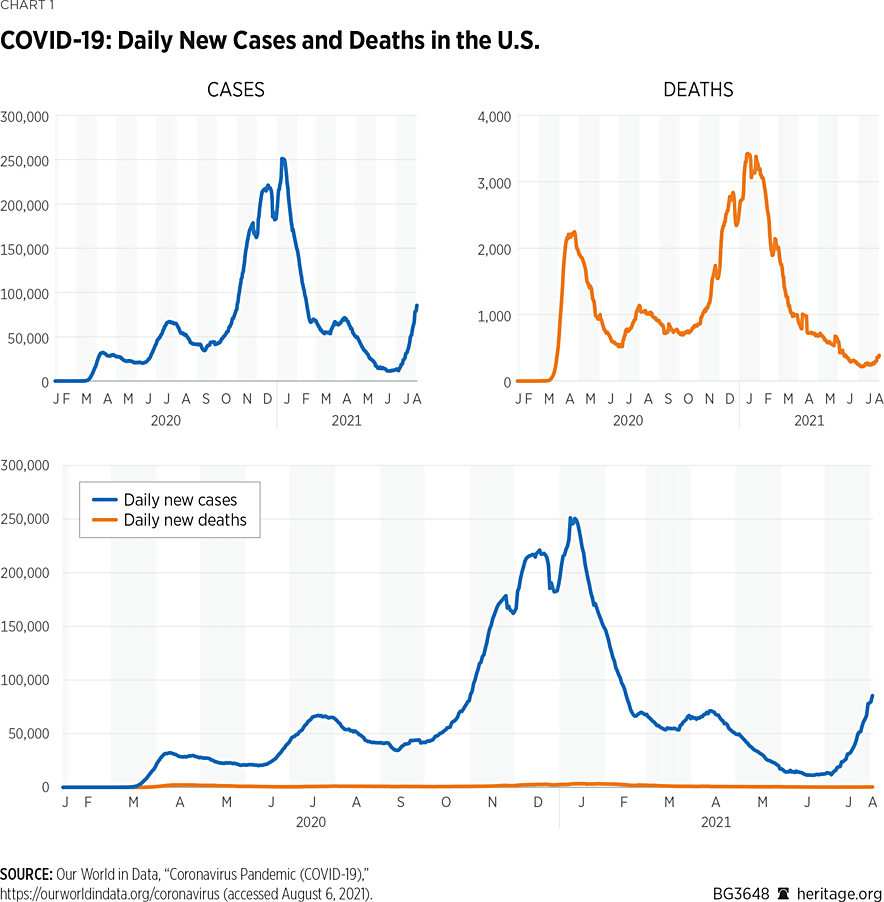
As Chart 1 illustrates, the virus has fluctuated significantly in the United States since early 2020, reaching its highest peak last winter.REF Three vaccines—produced by Pfizer, Moderna, and Johnson & Johnson—have received emergency use authorization from the U.S. Food and Drug Administration. Both new cases and deaths have, for the most part, declined significantly through spring 2021. Chart 2 presents the number of doses given to the general public by each manufacturer.
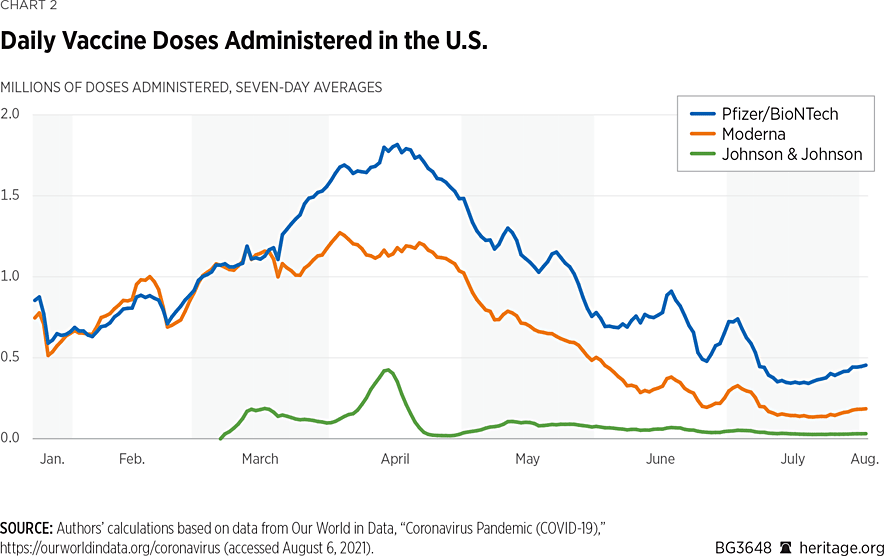
During early 2021, there was tremendous demand for vaccines, with many people having difficulty scheduling appointments and some websites even crashing due to high traffic.REF Since April 2021, however, the number of doses administered has steadily declined for all three vaccines. The Institute for Health Metrics and Evaluation (IHME) at the University of Washington School of Medicine conducted a statistical analysis of survey data and noted that a significant fraction of the American population is vaccine hesitant, which has likely contributed to this decline.REF According to the American Academy of Family Physicians, the main reasons for hesitancy include concerns about safety and efficacy, preference for physiological immunity, distrust of government and health organizations, and desire for autonomy and personal freedom.REF
As Chart 1 demonstrates, COVID-19 cases and deaths declined significantly for much of the first half of 2021 as more Americans were vaccinated. While the U.S. is experiencing a surge in cases due to the Delta variant, most of these cases are among the unvaccinated, and COVID-19 deaths are nowhere near the levels before vaccines were authorized.
Furthermore, as of August 4, 2021, more than 164 million Americans were fully vaccinated against COVID-19, with 191 million people having acquired partial immunity through at least one dose.REF Yet, among those fully vaccinated, the CDC reports 7,525 COVID-19 patients who either were hospitalized or died, a figure representing 0.005 percent of the fully vaccinated.REF According to the CDC, 74 percent of these cases were people ages 65 and older, 26 percent of these hospitalizations were reported as asymptomatic or not related to COVID-19, and 21 percent (316) of the 1,507 fatal cases were reported as asymptomatic or not related to COVID-19.REF
The CDC’s New Public Health Recommendations
As a result of the recent increases in cases due to the Delta variant, the CDC updated its “Interim Public Health Recommendations for Fully Vaccinated People.”REF The updates include the recommendation that the fully vaccinated “wear a mask in public indoor settings in areas of substantial or high transmission.” The updated guidelines also include the following three recommendations:
- Fully vaccinated people might choose to wear a mask regardless of the level of transmission particularly if they are immunocompromised or at increased risk for severe disease from COVID-19, or if they have someone in their household who is immunocompromised, at increased risk of severe disease, or not fully vaccinated (emphasis added);
- Fully vaccinated people who have come into close contact with someone with suspected or confirmed COVID-19 should be tested three to five days after exposure, and wear a mask in public indoor settings for 14 days or until they receive a negative test result; and
- Universal indoor masking for all teachers, staff, students, and visitors to schools, regardless of vaccination status.REF
At the very least, these new guidelines—along with Walensky’s statements—give the impression that the CDC’s new report provides evidence that masks provide better protection than vaccines against contracting COVID-19. The new report simply does not contain such evidence, and the CDC’s latest moves run the risk of increasing vaccine hesitancy. These mixed signals are particularly disturbing because, especially compared to vaccinations, the effectiveness of surgical or cloth masks in meaningfully reducing COVID-19 transmission is not supported by a review of the professional literature. Moreover, evidence shows that mask mandates have done little—if anything—to curb the transmission of the virus and is even less likely to do so compared to vaccinations.REF
Interestingly, the CDC’s “Science Brief,”REF which claims to provide evidence that wearing cloth masks help to control the spread of COVID-19, dismisses the findings of the one controlled study that examines whether masks protect uninfected people from contracting COVID-19. That study found no statistical difference in infection rates between those wearing masks and those not wearing masks.REF In any case, the new CDC paper indisputably does not study the effectiveness of masks in preventing COVID-19 transmission—neither in the vaccinated nor in the unvaccinated.
The CDC “Study” of Barnstable County, Massachusetts
The CDC based its new recommendations on a July 30 Morbidity and Mortality Weekly Report (MMWR) article.REF The authors of that article reported that 469 COVID-19 cases were associated with multiple summer events in Barnstable County, Massachusetts, starting around July 4.REF Approximately three-quarters (346) of the cases occurred in fully vaccinated persons, and 274 of the cases were symptomatic. The authors also report that 133 cases had the Delta variant, that just five of the cases resulted in hospitalizations, and that no deaths have been associated with the outbreak.REF Finally, the MMWR also reports that the viral loads in 127 of the fully vaccinated people who contracted COVID-19 were “similar to those among 84 patients who were unvaccinated, not fully vaccinated, or whose vaccination status was unknown.”REF
Beyond reporting these statistics, the MMWR provides little additional information other than discussing key limitations to the data. One key limitation is that the qualitative results “might mean that the viral load of vaccinated and unvaccinated persons infected with SARS-CoV-2 is also similar,” but that “microbiological studies are required to confirm these findings.”REF This limitation is even more problematic given issues regarding the sample.
The MMWR acknowledges that asymptomatic infections are likely underrepresented in the data, and that “demographics of cases likely reflect those of attendees at the public gatherings.”REF (Emphasis added.) This last limitation is critical because the report recognizes that the sample may not even be truly representative of the people who attended the events in Barnstable.REF In statistical terms, the sample is heavily biased—the only people included in the data are those who were in Barnstable during the festivities and who reported contracting COVID-19.
It is a mistake, therefore, to project these results onto the general U.S. population, or even to a randomly selected person who attended the festivities in Barnstable. It would be grossly irresponsible, for example, to use the data in the MMWR to suggest that the typical vaccinated American has similar chances of contracting COVID-19—much less becoming severely ill from such an occurrence—to those of someone who is not vaccinated. Indeed, it is completely unsurprising that the authors include the following disclaimer: “data from this report are insufficient to draw conclusions about the effectiveness of COVID-19 vaccines against SARS-CoV-2, including the Delta variant, during this outbreak.”REF
The only mystery is why the MMWR includes this language:
Findings from this investigation suggest that even jurisdictions without substantial or high COVID-19 transmission might consider expanding prevention strategies, including masking in indoor public settings regardless of vaccination status, given the potential risk of infection during attendance at large public gatherings that include travelers from many areas with differing levels of transmission.REF
The MMWR does not, in any way, provide statistical evidence for these recommendations: There was no investigation of these prevention strategies—none—among the vaccinated or unvaccinated. In fact, given the underlying data, it is difficult to see how including this sentence in the MMWR could do anything other than mislead the public and unnecessarily spread fear.
Potential Positivity Rates and Hope
Since the publication of the MMWR, new cases were linked to the festivities and reported to the Barnstable County Department of Health. As of July 29, the total number of confirmed COVID-19 cases was 934, with 560 cases from the state of Massachusetts. The data indicates that 73 percent of the Massachusetts residents who tested positive were vaccinated, but the health department does not (or is unable to) specify the vaccination rate of all positive cases after including out-of-state visitors.REF These updates do not change the analysis of the MMWR, but we do account for the new information in our own estimates of positivity rates (the percentage of people attending the festival who tested positive for COVID-19).
As alluded to in the previous section, the MMWR fails to provide any context regarding how many people who attended the festivities (or the general population) in Barnstable were fully vaccinated.REF At best, this flaw means that the report is incomplete because it does not provide even a reasonable estimate of the positivity rate surrounding the events in Barnstable. In this Backgrounder, we provide these estimates for the vaccinated and unvaccinated.
The first piece of information needed is the number of people who attended the festivities. While it is impossible to know that figure with certainty, at least two public estimates suggest that approximately 60,000 people attended the events in Barnstable.REF There is, perhaps, less guesswork involved in obtaining a realistic estimate of the next necessary piece of information: the number of people vaccinated.
According to The New York Times, the State of Massachusetts and Barnstable County have adult vaccination rates of 74.8 percent and 76 percent, respectively.REF The town of Provincetown itself (where many of the celebratory events took place) has a vaccination rate of 95 percent.REF Although it is unclear what the actual vaccination rate was among the attendees, Dr. Ingu Yun, who attended the festivities and engaged in a similar analysis associated only with fully vaccinated people, suggests that the vaccination rate of attendees was well above 90 percent.REF
To derive a base estimate, we assume an overall vaccination rate of 90 percent, among 60,000 attendees of the public gatherings in Barnstable, along with a vaccination rate of 70 percent among the positive cases. These assumptions result in positivity rates of 1.21 percent for the vaccinated, and 4.67 percent for the unvaccinated. (See Table 1.)
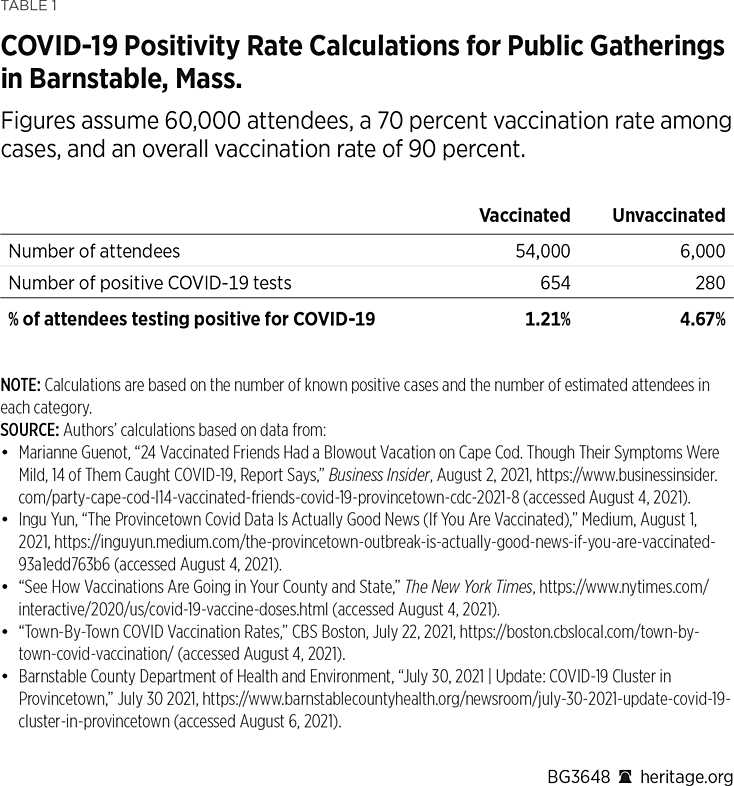
That is, assuming a 90 percent vaccination rate, only 1.21 percent of the estimated 54,000 vaccinated attendees, and 4.67 percent of the estimated 6,000 unvaccinated, tested positive for COVID-19. Of course, the festivities had many out-of-town visitors, making it difficult to ascertain the true vaccination rate among attendees. Therefore, we estimate positivity rates for a range of vaccination coverage. Chart 3 presents positivity-rate estimates with vaccine rates ranging from 60 percent (the national adult vaccination rateREF) to 95 percent.
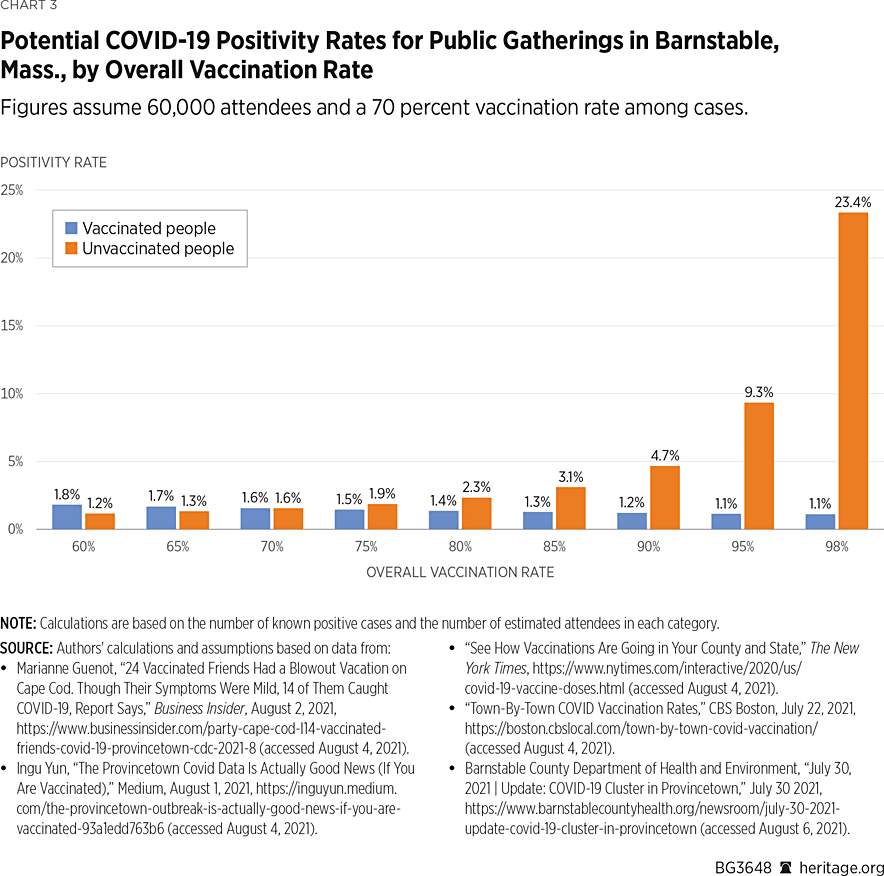
As Chart 3 illustrates, under all such assumptions, the percentage of the breakthrough cases (associated with the Barnstable festivities) among the vaccinated is less than 2 percent of the estimated population of attendees. The MMWR provides no such analysis, thus omitting critical context for how COVID-19 might spread among the vaccinated. Thus, headlines, such as “74 Percent of People Infected in Massachusetts Covid Outbreak Were Fully Vaccinated,” are highly misleading and risk needlessly creating panic.REF
It is true that 74 percent of the attendees who later reported contracting COVID-19 were fully vaccinated, but that figure, under the assumptions made in Chart 3, represents—at most—less than 2 percent of the attendees. More important, out of these 133 COVID-19 patients who had the Delta variant, five were hospitalized (0.008 percent of the estimated attendees) and not a single person died.REF
According to the CDC’s most recent data on breakthrough cases (those where a fully vaccinated person contracts COVID-19), of more than 164 million fully vaccinated Americans, there have been 7,101hospitalizations and 1,507 deaths.REF The CDC also notes that 26 percent of these hospitalizations and 21 percent of the deaths were “asymptomatic or not related to COVID-19.”REF
Vaccines clearly provide substantial protection against COVID-19—among the fully vaccinated, these figures represent 0.003 percent hospitalized and 0.0007 percent deaths. These percentages indicate that the odds of a fully vaccinated person being hospitalized due to COVID-19 are approximately 1 in 31,000, while the odds of dying are 1 in 137,000. To better put these odds in perspective, it is useful to examine the odds of various causes of death published by the National Safety Council.
Alternative Causes of Death. Sadly, people die each year. In 2019, the National Safety Council used data from the National Center for Health Statistics to estimate the odds of various lifetime causes of death, including (among others) heart disease, cancer, pedestrian incidents, and drowning. Heart disease, cancer, and other chronic lower respiratory diseases constituted some of the highest causes of death in 2019 (with odds of 1 in 6, 1 in 7, and 1 in 27, respectively).
There were many other causes of death albeit occurring at much lower frequencies. For example, motor vehicle crashes were associated with a 1 in 103 odds of dying, gun assaults were associated with a 1 in 289 odds of dying, and hornet wasp and bee stings were associated with a 1 in 59,507 odds of dying.REF In Chart 4, we compare the odds of a fully vaccinated person dying from COVID-19 to the odds of various other causes of death (as estimated by the National Safety Council).
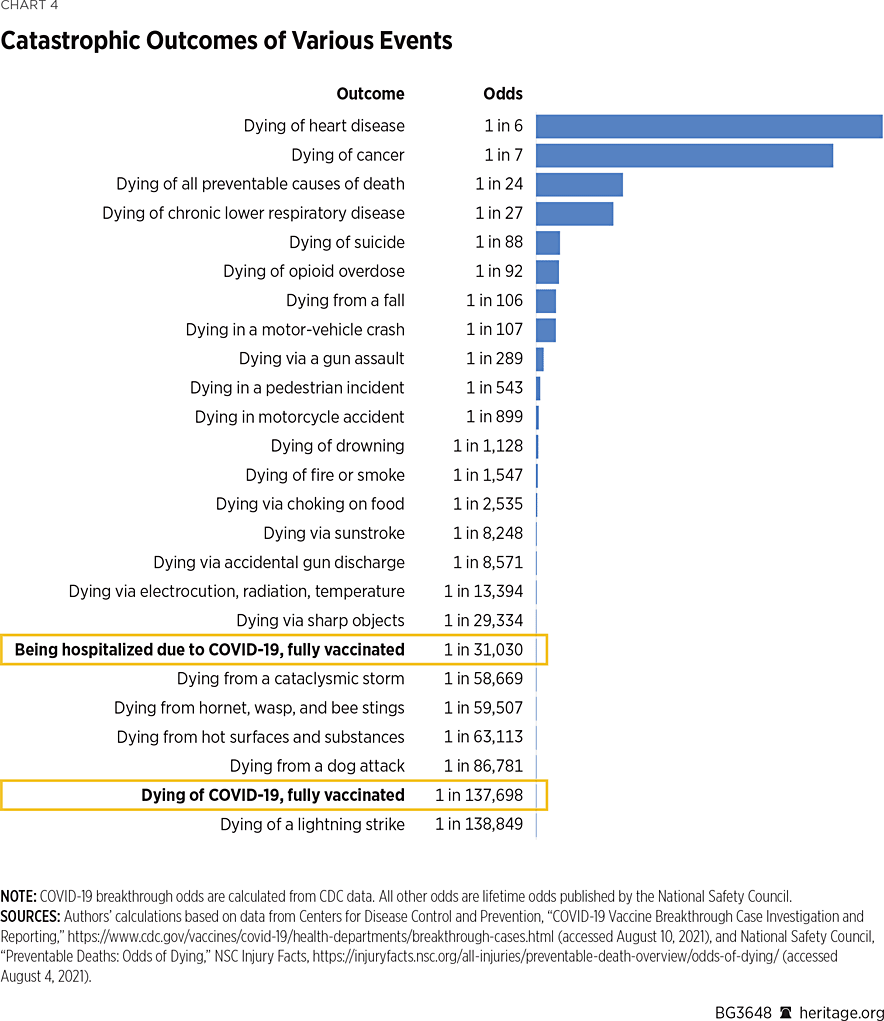
As Chart 4 illustrates, typical causes of death, such as heart disease, cancer, and chronic lower respiratory diseases are still more likely to take people’s lives than a breakthrough case of COVID-19. In fact, the odds of dying of COVID-19 after being fully vaccinated are lower than getting killed in a dog attack or getting killed by a swarm of bees. In fact, as Chart 4 illustrates, the odds of dying of COVID-19 after being fully vaccinated are comparable to dying by lightning strike.
For the elderly unvaccinated, and the unvaccinated with chronic health conditions, COVID-19 is still quite deadly, as has been discussed extensively in prior Heritage Foundation research.REF Chart 5 presents the probability of survival for various age groups. As this graphic illustrates, although most people do survive COVID-19, the disease does have significantly lower survival probabilities for the elderly than does influenza.REF
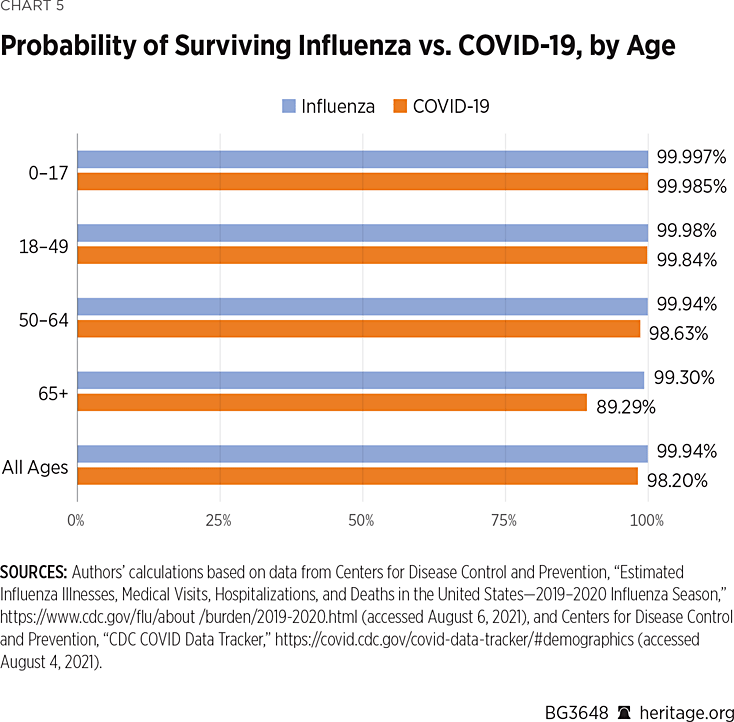
While vaccines for COVID-19 do not provide 100 percent protection against infection or death, neither do many other vaccines, including the influenza vaccine.REF For instance, according to the CDC, 49.2 percent of Americans ages six months and older were vaccinated against influenza between 2018 and 2019, yet 34,200 influenza deaths occurred during this period.REF Just as important, the CDC estimates that flu vaccines have (in recent years) “reduced the risk of flu-associated hospitalizations among older adults on average by about 40 percent,” and that between 2012 and 2015 they reduced adults’ risk “of being admitted to an intensive care unit (ICU) with flu by 82 percent.”REF
Policy Implications
More than one year after the COVID-19 pandemic started in the U.S., a wealth of data is now available to policymakers and the public. It is critical that government officials rely on this evidence and stop politicizing public health issues. At the very least, officials should follow these two recommendations. Officials should:
- Promote vaccines, not mask mandates. The evidence shows that vaccines provide significant protection against serious illness or death from the virus, including the Delta variant. The evidence also shows that mask mandates do not meaningfully curb disease proliferation. Lawmakers should therefore focus on encouraging the vaccine hesitant to get vaccinated rather than requiring the already vaccinated to wear masks. Mask mandates, particularly for the vaccinated, will likely discourage the unvaccinated from reconsidering, and thus prolong the pandemic.
- Focus on the data and ensure that they are presented accurately. The CDC and other government agencies should make more data about breakthrough cases publicly available and present them in the context of the overall fully vaccinated population, not self-selected non-random samples. As of now, the CDC does not provide detailed COVID-19 breakthrough data by age category as they do for overall infections. Given the small total number of such cases, releasing such data every week may not be informative. Nonetheless, officials have a duty to avoid politicizing COVID-19 by presenting data accurately and responsibly.
Conclusion
COVID-19 is a highly communicable disease that spreads rapidly, even in communities under lockdown orders.REF It is virtually impossible to eradicate the risk of infection. However, as illustrated in Chart 5, not everyone is at equal risk of serious illness or death from COVID-19. Public health officials and news outlets seem to have a significant amount of trouble differentiating between the risk of infection and the risk of serious illness and death—which is predominantly a problem among the unvaccinated, especially the elderly. This failure amongst officials to recognize the value of more targeted public health approaches has needlessly created panic and prolonged the pandemic.
According to CDC estimates, the Delta variant represented more than 80 percent of new U.S. COVID-19 cases at the end of July 2021. Unfortunately, the CDC has done a poor job of using evidence to calm the public’s fears throughout the pandemic, and its latest public health guidelines for the fully vaccinated are no exception to that rule.
CDC Director Walensky announced these new guidelines based on data that allegedly imply that the vaccines offer little protection against the Delta variant. However, the CDC report fails to support this conclusion. In fact, the authors of the CDC report provide an explicit warning: “[D]ata from this report are insufficient to draw conclusions about the effectiveness of COVID-19 vaccines against SARS-CoV-2, including the Delta variant, during this outbreak.”REF
Despite the CDC’s misuse of the data in the new report, the overall evidence remains clear: Vaccines for COVID-19 have provided people with significant protection against serious illness or death from the virus, including the Delta variant. Public health guidelines should reflect this reality.
Kevin Dayaratna, PhD, is Principal Statistician, Data Scientist, and Research Fellow in the Center for Data Analysis, of the Institute for Economic Freedom and Opportunity, at The Heritage Foundation. Norbert J. Michel, PhD, is Director of the Center for Data Analysis.



